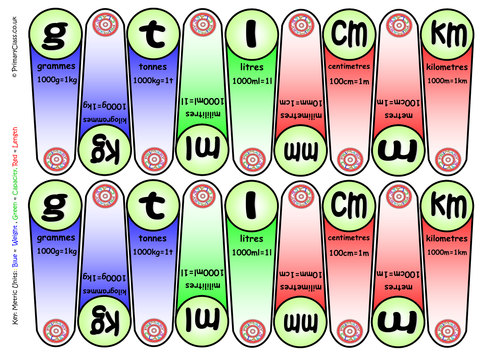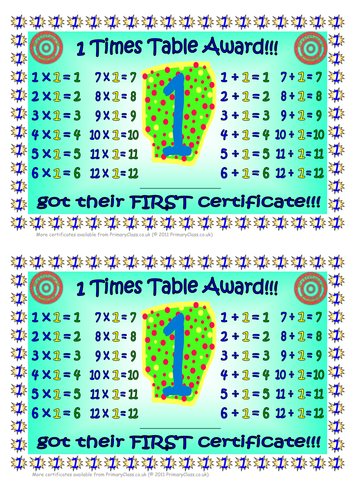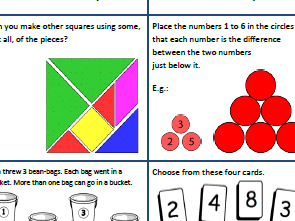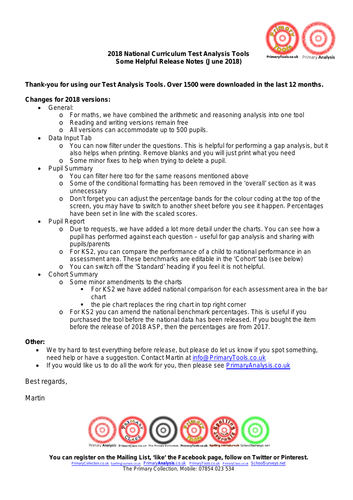
284Uploads
2082k+Views
2046k+Downloads
Math

2016 KS1 Data Analysis Tool
Analyse your KS1 assessments with ease for Reading, Writing, Mathematics and Science.
Automatically calculates attainment using the new National Curriculum language and breaks down the data for the following key groups:
Whole Cohort (up to 125 pupils)
By Class (up to four classes)
Disadvantaged/Non Disadvantaged
Gender
Sen/Non SEN
Recommended: Excel 2010 onwards with macros enabled

Multiplication Wristbands - Editable
Multiplication Wristbands from x2 to x12 with different coloured backgrounds. 5 per A4 sheet. 19 different coloured editable versions also available. Visit elementary-class.com for full sets. Aligned to Common Core State Standards: 3.OA.1, 3.OA.2, 3.OA.3, 3.OA.4, 3.NBT.3, 4.OA.4

Times Tables Multuplication/Division Certificates
To reward your pupils as they learn their multiplication tables.

Multiplication / Times Tables Spinner Games
For the following times tables:
x2, x3, x4, x5,x6, x7, x8, x9, x10, x11, x12
Level D (Practice): Yellow, Answers and Arrays
Level C: Blue, Arrays only
Level B: Red, Questions only, in order
Level A: Rainbow, Questions only in random order
Bonus spinner for useful multiplication facts: x20, x25, x0.1,x 0.2, x0.01, x0.02
Bonus spinner for tricky division
Bonus spinner for square numbers
Bonus spinner for measurement conversion
Print, cut, laminate, cut, cut hole, insert spinner - done!
A minor hint if you want to save on time and preparation is to print just level C and A only and glue back to back before laminating. The spinner can then be reversed when needed.
Spinners can be bought for just a few pounds from ebay etc

Year 1 and 2 Mathematics Challenges for every day of the Summer Holidays
Year 1 and 2 Mathematics Challenges for every day of the Summer Holidays

Year 5 and 6 Mathematics Challenges for every day of the Summer Holidays
Year 5 and 6 Mathematics Challenges for every day of the Summer Holidays
Comes on two A4 sheets.

Year 3 and 4 Mathematics Challenges for every day of the Summer Holidays
Year 3 and 4 Mathematics Challenges for every day of the Summer Holidays

2016 KS2 Mathematics Test Electronic Analysis
Produces easy on the eye tables and charts for cohorts and individuals. Broken down into areas of learning and specific question performance.
Paper 1 Arithmetic (up to 250 pupils)
Papers 2 & 3 Reasoning: Up to 1000 pupils with individual pupil reporting (works best in Excel 2010 or later with macros enabled)
Full free 2016 KS2 Reading Analysis Tool available here:
https://www.tes.com/teaching-resource/2016-ks2-test-electronic-analysis-for-reading-11291700
Grammar, Punctuation and Spelling Version also available:
https://www.tes.com/teaching-resource/2016-ks2-grammar-punctuation-and-spelling-test-electronic-analysis-11291706

2018 KS1 National Curriculum (SATs) Test Analysis for Mathematics
2018 KS1 National Curriculum (SATs) Test Analysis for Mathematics.
Please see release notes for new features.
Analysis for all tests is available elsewhere on TES or from our website.

2017 KS2 National Curriculum Test for Mathematics Electronic Analysis
New features for the 2017 version include Age Related Expectations reporting and improved presentation of graphs.
Paper 1 Arithmetic (up to 250 pupils)
Papers 2 & 3 Reasoning: Up to 1000 pupils with individual pupil reporting
Works best in Excel 2010 or later with macros enabled

2024 KS1 Mathematics Question Level Analysis
2024 KS1 Mathematics Question Level Analysis
Requires Excel with macros enabled.
Instant download after purchase. Maximum of 5 downloads.
Please note sample pictures are for the KS2 Mathematics Analysis.
Summary of Features (please note some features may not be available depending on the test type):
Pupil Summary shows total marks for each paper, number of questions unanswered (possibly indicating need to increase pace), number of incorrect answers, total overall score (and percent), total score in each strand. Option to adjust the colour thresholds to make it easier to spot patterns and gaps.
Pupil Reports show a summary of performance in each strand for an individual pupils. Available in 2016 versions and later. Useful for feeding back to pupils, parents and informing intervention teachers.
Contextual Analysis (2019 versions onwards) shows a breakdown by key groups (gender, SEND status, disadvantaged, EAL) plus up to four custom groups. Compares school data (grades and scaled scores) to national data in a detailed but user-friendly report.
Cohort Summary shows an overview of the cohort against each strand. This is also compared to national data where it is available. This page gives a summary of attainment including number and percent at expected and higher standard.
Strand Summary shows a the weighting of each strand and the performance within it. For example, in a grammar test a cohort may perform poorly in identifying sentence types and equally poorly in identifying punctuation. However as there is more weighting given to punctuation, it would be advisable to focus on this area.
Other Charts Charts which show performance for each question, organised by most correct to incorrect, by strand and also by year group question (for mathematics). The most powerful chart orders questions from most correct to incorrect enabling you to see precisely where there are strengths and weaknesses.
2024 KS1 Mathematics Question Level Analysis (SATs)

2023 KS1 SATs Mathematics Test and Question Level Analysis
2023 KS1 Mathematics Test and Question Level Analysis
Requires Excel with macros enabled.
Summary of Features (please note some features may not be available depending on the test type):
Pupil Summary shows total marks for each paper, number of questions unanswered (possibly indicating need to increase pace), number of incorrect answers, total overall score (and percent), total score in each strand. Option to adjust the colour thresholds to make it easier to spot patterns and gaps.
Pupil Reports show a summary of performance in each strand and per question for an individual pupils. Useful for feeding back to pupils, parents and informing intervention teachers.
Contextual Analysis shows a breakdown by key groups (gender, SEND status, disadvantaged, EAL) plus up to four custom groups. Compares school data (grades and scaled scores) to national data in a detailed but user-friendly report.
Cohort Summary shows an overview of the cohort against each strand. This is also compared to national data where it is available. This page gives a summary of attainment including number and percent at expected and higher standard.
Strand Summary shows a the weighting of each strand and the performance within it. For example, in a grammar test a cohort may perform poorly in identifying sentence types and equally poorly in identifying punctuation. However as there is more weighting given to punctuation, it would be advisable to focus on this area.
Other Charts Charts which show performance for each question, organised by most correct to incorrect, by strand and also by year group question (for mathematics). The most powerful chart orders questions from most correct to incorrect enabling you to see precisely where there are strengths and weaknesses.

2019 KS2 Mathematics Question Level Analysis
Summary of Features (please note some features may not be available depending on the test type):
Pupil Summary shows total marks for each paper, number of questions unanswered (possibly indicating need to increase pace), number of incorrect answers, total overall score (and percent), total score in each strand. Option to adjust the colour thresholds to make it easier to spot patterns and gaps.
Pupil Reports show a summary of performance in each strand for an individual pupils. Available in 2017 versions and later excluding reading. 2018 versions and later contain detailed feedback on each question. Useful for feeding back to pupils, parents and informing intervention teachers.
Cohort Summary shows an overview of the cohort against each strand. This is also compared to national data where it is available. This page gives a summary of attainment including number and percent at expected and higher standard.
Strand Summary shows a the weighting of each strand and the performance within it. For example, in a grammar test a cohort may perform poorly in identifying sentence types and equally poorly in identifying punctuation. However as there is more weighting given to punctuation, it would be advisable to focus on this area.
Other Charts Charts which show performance for each question, organised by most correct to incorrect, by strand and also by year group question (for mathematics). The most powerful chart orders questions from most correct to incorrect enabling you to see precisely where there are strengths and weaknesses.

Rapid Arithmetic - 48 Rapid Arithmetic Activities for Upper Key Stage 2
48 Quick Arithmetic activities for Upper Key Stage 2
Quick activities designed to last up to 10 minutes. Based on the 2016 test frameworks and arithmetic requirements in the National Curriculum from 2014.
Includes new and original questions
Categorised questions
Answers included.
Sample file can be found here including 3 of the 48 activities:
https://www.tes.com/teaching-resource/rapid-arithmetic-48-quick-arithmetic-activities-for-upper-key-stage-2-11251826

Rapid Arithmetic for Lower Key Stage 2
48 activities designed to last up to 10 minutes for Lower Key Stage 2
Based on the 2016 test frameworks and arithmetic requirements in the National Curriculum from 2014.
Includes:
-New and original questions
-Categorised questions
-Answers.

2024 KS2 SATs Mathematics Test and Question Level Analysis
2024 KS2 Mathematics Test and Question Level Analysis
Requires Excel with macros enabled.
Summary of Features
Pupil Summary shows total marks for each paper, number of questions unanswered (possibly indicating need to increase pace), number of incorrect answers, total overall score (and percent), total score in each strand. Option to adjust the colour thresholds to make it easier to spot patterns and gaps. All Versions from 2016.
Pupil Reports show a summary of performance in each strand for an individual pupils. Useful for feeding back to pupils, parents and informing intervention teachers. All Versions from 2016.
Contextual Analysis shows a breakdown by key groups (gender, SEND status, disadvantaged, EAL) plus up to four custom groups. Compares school data (grades and scaled scores) to national data in a detailed but user-friendly report. All Versions from 2016.
Cohort Summary shows an overview of the cohort against each strand. This is also compared to national data where it is available. This page gives a summary of attainment including number and percent at expected and higher standard. All Versions from 2016.
Strand Summary shows a the weighting of each strand and the performance within it. For example, in a grammar test a cohort may perform poorly in identifying sentence types and equally poorly in identifying punctuation. However as there is more weighting given to punctuation, it would be advisable to focus on this area. All Versions from 2016.
Other Charts Charts which show performance for each question, organised by most correct to incorrect, by strand and also by year group question (for mathematics). The most powerful chart orders questions from most correct to incorrect enabling you to see precisely where there are strengths and weaknesses. All Versions from 2016.

2022 KS2 Mathematics Test and Question Level Analysis
2022 KS2 Mathematics Test and Question Level Analysis
Requires Excel with macros enabled.
Summary of Features (please note some features may not be available depending on the test type):
Questions Versus National compares the performance of your cohort against the performance of pupils nationally in each question. A powerful chart which instantly shows you which questions you are strong or weak on. As it uses national data, it considers the difficulty of each question, compares it the performance of your cohort and orders the results from strongest to weakest. 2016 to 2022 KS2 versions only, Q vs National will be added to the 2023 KS2 version at a later date.
Pupil Summary shows total marks for each paper, number of questions unanswered (possibly indicating need to increase pace), number of incorrect answers, total overall score (and percent), total score in each strand. Option to adjust the colour thresholds to make it easier to spot patterns and gaps.
Pupil Reports show a summary of performance in each strand for an individual pupils. Available in 2017 versions and later excluding reading. 2018 versions and later contain detailed feedback on each question. Useful for feeding back to pupils, parents and informing intervention teachers.
Contextual Analysis (2019 versions onwards) shows a breakdown by key groups (gender, SEND status, disadvantaged, EAL) plus up to four custom groups. Compares school data (grades and scaled scores) to national data in a detailed but user-friendly report.
Cohort Summary shows an overview of the cohort against each strand. This is also compared to national data where it is available. This page gives a summary of attainment including number and percent at expected and higher standard.
Strand Summary shows a the weighting of each strand and the performance within it. For example, in a grammar test a cohort may perform poorly in identifying sentence types and equally poorly in identifying punctuation. However as there is more weighting given to punctuation, it would be advisable to focus on this area.
Other Charts Charts which show performance for each question, organised by most correct to incorrect, by strand and also by year group question (for mathematics). The most powerful chart orders questions from most correct to incorrect enabling you to see precisely where there are strengths and weaknesses.
2022 KS2 Mathematics Test and Question Level Analysis
Bundle

2018 KS1 Test and Writing Analysis Bundle
Test analysis for 2018 KS1 Mathematics, Grammar and Reading Tests . Plus the 2018 Writing analysis tool.




















